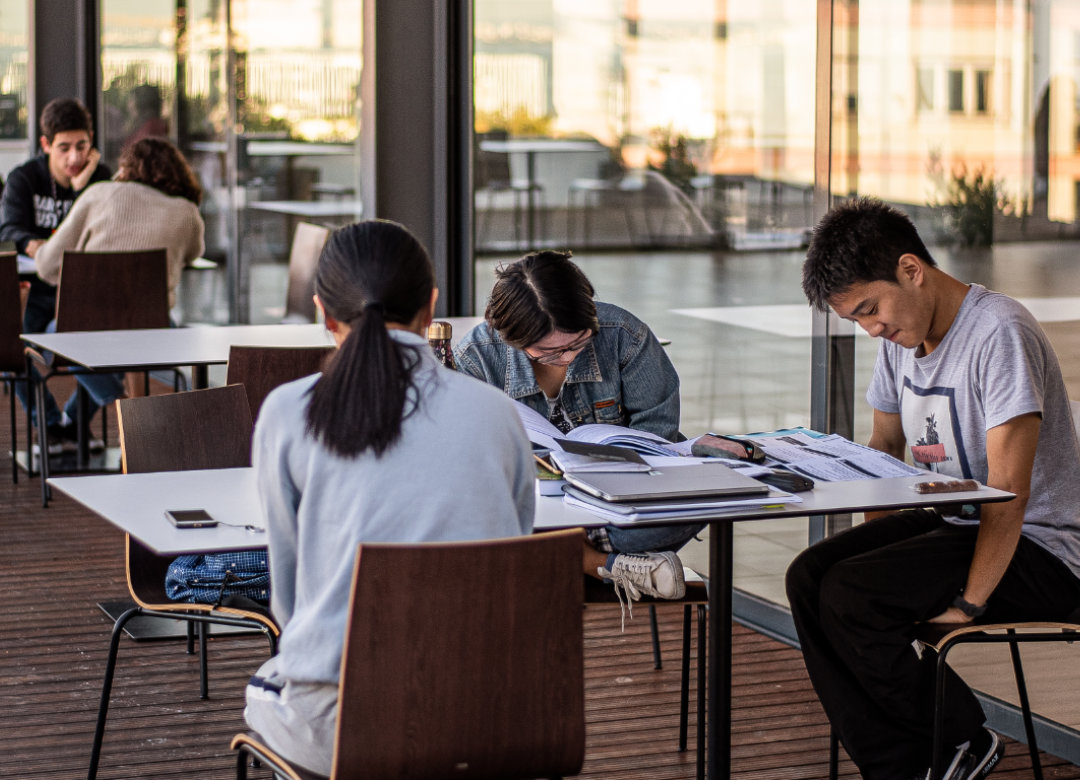What is the Bologna Process?
ISEG's courses are in line with the Bologna Process. Its main objective is to establish a coherent, compatible, competitive and attractive European Higher Education Area (EHEA) for European and third-country students, promoting European cohesion through knowledge, mobility and the employability of its graduates.
According to the Bologna Process, courses are organized into three cycles:
1st Cycle - Degree
2nd Cycle - Master's Degree
3rd Cycle - Doctorate
What are the objectives of the Bologna Process?
In general terms, the aims of this reform are as follows:
- Increasing competitiveness and quality in European Higher Education;
- Promoting Lifelong Learning (LLL);
- Increasing the mobility of European citizens by promoting:
- The compatibility of degrees at European level;
- The readability of curricula by universities and employers;
- The commensurability of the training segments at the different levels;
- Promoting the recognition of qualifications and skills;
- Encouraging greater student involvement in the management of their academic career and universities;
- Broadening opportunities for access to higher education;
- Promoting a European Higher Education Area (EHEA).
What are the reforms instituted by the Bologna Process?
The reforms that this process institutes can be summarized as follows:
- A new way of organizing teaching, centered on the student and the development of skills;
- Institution of academic degrees with:
- Similar and inter-comprehensible nomenclatures in all countries;
- Similar and inter-comprehensible nomenclatures in all countries;
- Similar training objectives;
- Restructuring of the ECTS credit system, which allows:
- Credit transfer: Allows a student undertaking a period of study at a foreign university to have the work carried out and the results obtained at the university and country of origin recognized;
- Accumulation of credits: All educational experiences will be "counted" in ECTS credits: university education, professional education, professional experience, after analysis by the institution;
- Implementation of the Diploma Supplement, aimed at increasing the transparency of qualifications and competences;
- Adoption of the European Classification Comparability Scale;
- Accreditation of Higher Education, through the development of evaluation procedures for the Portuguese Higher Education System and Educational Institutions.
In practice, what changes will the Bologna Process introduce?
- Courses last six academic semesters;
- Institution of optional subjects, to be chosen by the student from a list pre-established by the University;
- Easier exchanges with foreign universities, particularly through the Erasmus Program;
- Diplomas recognized in all countries adhering to the Bologna Declaration.
Are ISEG's courses reorganized according to the Bologna Process?
Yes. Since the 2007/08 academic year, all ISEG courses have followed the new organizational model, in accordance with the Bologna Process.
What is ECTS? What does it consist of?
ECTS - the European Credit Transfer System - is an instrument whose purpose is to create transparency, establish conditions for closer ties between higher education institutions and broaden the options offered to students for their period of study abroad.
ECTS was developed by the European Commission to establish common procedures to guarantee the academic recognition of studies carried out abroad. It also allows academic results to be measured and compared and transferred from one institution to another.
It is a system in which credits are proportional to the student's total workload and not to the number of hours of classes.
ECTS credits represent, in the form of a value (between 1 and 60) assigned to each course unit, the student's workload, expressing only the portion that each course unit represents in relation to the total workload required to successfully complete a full year of studies: lectures, practical work, seminars, preparation of reports, bibliographical research, individual work and exams or other forms of assessment.
Each academic year of any study plan corresponds to a total of 60 ECTS credits:
- 30 ECTS credits are generally equivalent to 1 semester;
- 60 ECTS credits represent the academic volume of 1 year of studies.
What degrees can you get? What are their characteristics?
Students will be able to obtain 3 academic degrees, with the following characteristics:
| Cycle | Grade | Duration | Credits required to obtain the degree |
|---|---|---|---|
| 1º | Degree | 6 / 8 sem. | 180 / 240 ECTS credits |
| 2º | Master's Degree | 3 / 4 sem. | 90 / 120 ECTS credits |
| 3º | Doctorate | No duration or credits defined by law |
The 1st cycle of studies is made up of an organized set of curricular units called a degree course, comprising 180 to 240 credits and a normal duration of between six and eight curricular semesters of student work.
The 2nd cycle of studies comprises 90 to 120 credits and a normal duration of between three and four curricular semesters of student work, or, exceptionally, 60 credits and a normal duration of two curricular semesters of work, provided that this duration corresponds to a stable and internationally consolidated practice in that specialty.
The 3rd cycle of studies, with a duration of around 180 credits, includes the preparation of an original thesis specifically designed for this purpose, appropriate to the nature of the branch of knowledge or specialty, and the possible completion of curricular units aimed at training for research, the whole of which is called a doctoral course, whenever the respective regulations so provide.
What is a credit?
Under ECTS, a credit is the unit of measurement for student work in all its forms, namely collective teaching sessions, personal tutorial sessions, internships, projects, fieldwork, study and assessment.
What is the European Classification Comparability Scale?
One of the biggest obstacles to student and worker mobility in Europe is the difficulty in understanding the grades obtained in other countries, since each system uses its own evaluation scale. For example, Italy uses a scale from 0 to 30.
To solve this problem, the European Grade Comparability Scale was created, which places students in the context of all graduates from the last three years. This way, employers know that if a candidate has obtained an A in a particular course, it means that they belong to the 10% group of graduates with the best final grade in the last three years. This scale is used in parallel with national scales.
| ECTS classification | Group |
|---|---|
| A | 10% of the students with the best grades |
| B | 35% students, together with the previous class |
| C | 65% students, together with previous classes |
| D | 90% students, in conjunction with previous classes |
| E | 100% students, together with previous classes |
| FX | Failed, but close to the minimum to pass |
| F | Fail |
What is the Diploma Supplement?
It is a bilingual document that complements and is an integral part of a diploma (course letter, master's letter, doctoral letter or diploma of a non-degree course included in a cycle of studies), which aims to help improve international transparency and the academic and professional recognition of qualifications (diplomas, degrees, certificates, etc.).
Describes the Portuguese higher education system and its framework in the education system at the time the diploma was awarded; characterizes the institution that provided the training and awarded the diploma; describes the training undertaken (degree, area, access requirements, normal duration, level), its objectives and competences; provides detailed information on the study plan and the results obtained; may include additional information on activities certified by the University.
Can students who have not completed their undergraduate degree enter the degrees created under the Bologna Declaration?
Yes. To do so, they must apply for re-entry at the ISEG Degree Office. They can also submit a request for accreditation, with the aim of recognizing the studies previously completed.
Do degrees resulting from the Bologna Process have the same value as previous degrees?
Yes. Although the training periods are shorter, the objectives set and the new teaching methodologies require greater involvement and work on the part of the students during their studies. Moving from 4 to 3 years doesn't mean a loss of quality, but rather a new way of looking at higher education and its training, which is more interactive and geared towards developing problem-solving skills.
What do you expect from a graduate?
The degree of licenciado is awarded to those who demonstrate:
- have knowledge and understanding of a training area at a level that:
- building on and deepening secondary level knowledge;
- is based on advanced teaching materials and corresponds to them;
- in some areas of the field, is at the cutting edge of the field;
- know how to apply the knowledge and understanding they have acquired in order to demonstrate a professional approach to the work carried out in their vocational area;
- the ability to solve problems in their area of training and to construct and substantiate their own arguments;
- the ability to collect, select and interpret relevant information, particularly in their area of training, enabling them to substantiate the solutions they advocate and the judgments they make, including relevant social, scientific and ethical aspects in their analysis;
- skills that enable them to communicate information, ideas, problems and solutions to both specialist and non-specialist audiences;
- learning skills that enable them to learn throughout their lives with a high degree of autonomy.
How does employability relate to lifelong learning?
Due to the rapid obsolescence of knowledge, the ability to remain "employable" depends on students being constantly up-to-date. The ability to learn and the capacity to make choices about the most suitable curriculum for your situation will become increasingly important.
What are the objectives of lifelong learning?
In the context of the Lisbon Strategy, the report on progress towards the Lisbon objectives shows that they are not being achieved, particularly with regard to adult participation in lifelong learning. On the other hand, the need to equip young people with relevant key competences and to improve their educational attainment levels has been recognized, within the framework of the European Union's Growth and Jobs guidelines.
Thus, the introduction of the concept of learning to learn refers to the ability to initiate and continue learning, to organize one's own learning, including through effective time and information management, both individually and in groups. This competence also implies that the individual is aware of his or her own learning method and needs, identifying the opportunities available, and has the ability to overcome obstacles to successful learning. This competence means acquiring, processing and assimilating new knowledge and skills and knowing how to seek and make use of advice.
Learning to learn requires learners to draw on previous life and learning experiences in order to apply new knowledge and skills in a variety of contexts - at home, at work, in education and training.
Motivation and confidence are key elements in acquiring this skill.











